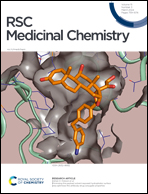Design and synthesis of novel chloropyridazine hybrids as promising anticancer agents acting by apoptosis induction and PARP-1 inhibition through a molecular hybridization strategy†
Abstract
Guided by the molecular hybridization principle, a novel series of 4-chloropyridazinoxyphenyl conjugates (3a–h, 4a–e, and 5) was designed and synthesized as proposed apoptotic inducers and PARP-1 inhibitors. The growth inhibition % of the designed hybrids was investigated in eleven cancer cell lines, where the anticancer activities were found to be in the following order: 4-chloropyridazinoxyphenyl-aromatic ketones hybrids (3a–h) > 4-chloropyridazinoxyphenyl-benzyloxyphenylethan-1-one hybrids (4a–e) > 4-chloropyridazinoxyphenyl-thiazolidine-2,4-dione hybrid (5). Further, the most sensitive three cancer cell lines (HNO97, FaDu, and MDA-MB-468) were selected to measure the IC50 values of the new hybrids. Moreover, the frontier three members (3c, 3e, and 4b) were selected for the measurements of apoptotic protein markers (p53, BAX, caspase 3, caspase 6, BCL-2, and CK 18). Besides, the impact of compounds 3a–e and 4b on the activity of PARP-1 was investigated, where 3c, 3d, and 3e demonstrated comparable efficiencies to olaparib. Furthermore, γ-H2Ax, a well-established marker for double-strand DNA breaks, was examined and the occurrence of DNA damage was observed. In addition, a significant inhibition of cell proliferation and a remarkable 15 to 50-fold reduction in the number of colonies compared to the control group were recorded. Finally, the PARP-1 inhibitory potential of the novel hybrids was compared to the co-crystal of the target receptor (PDB ID: 6NTU) using molecular docking.



 Please wait while we load your content...
Please wait while we load your content...